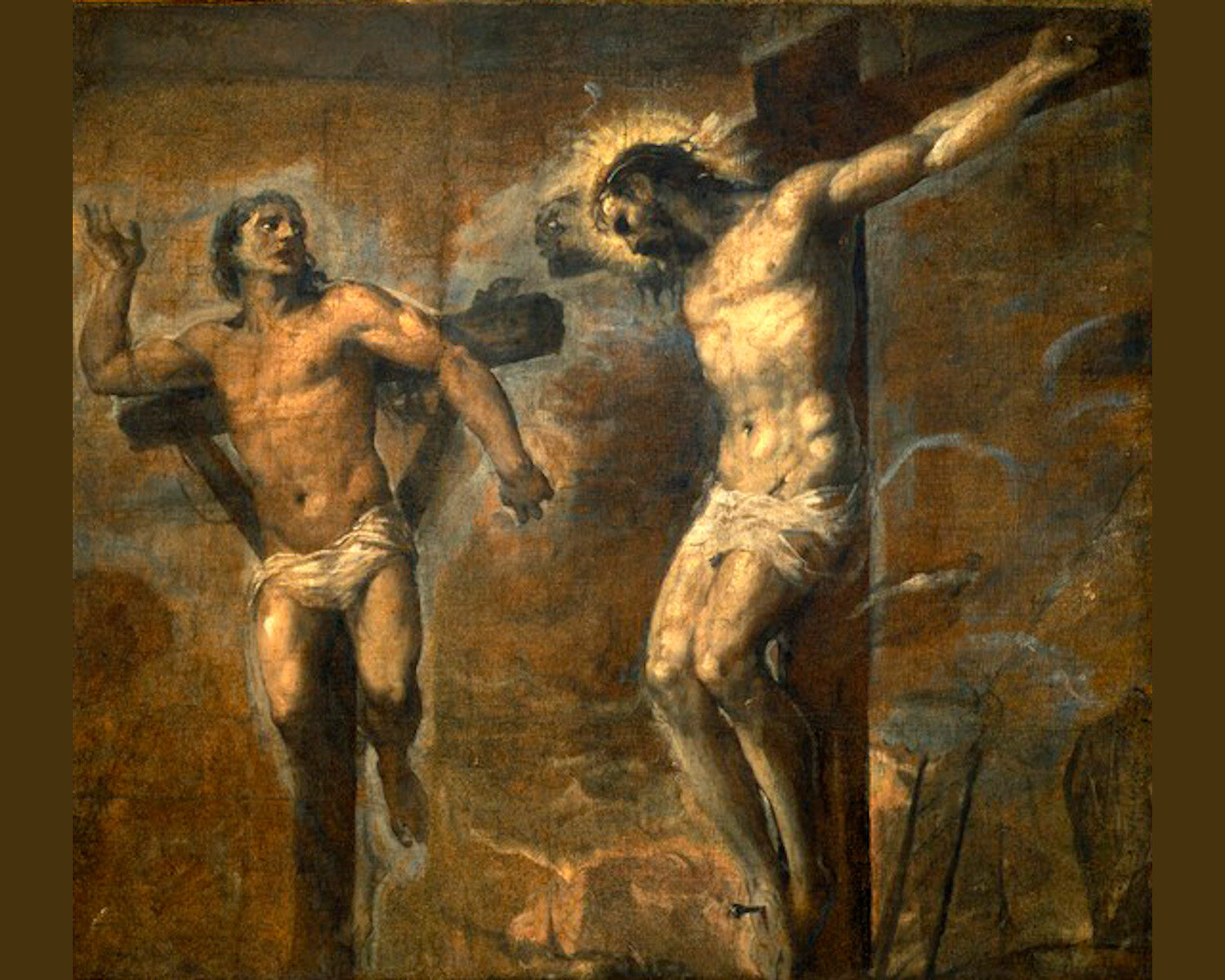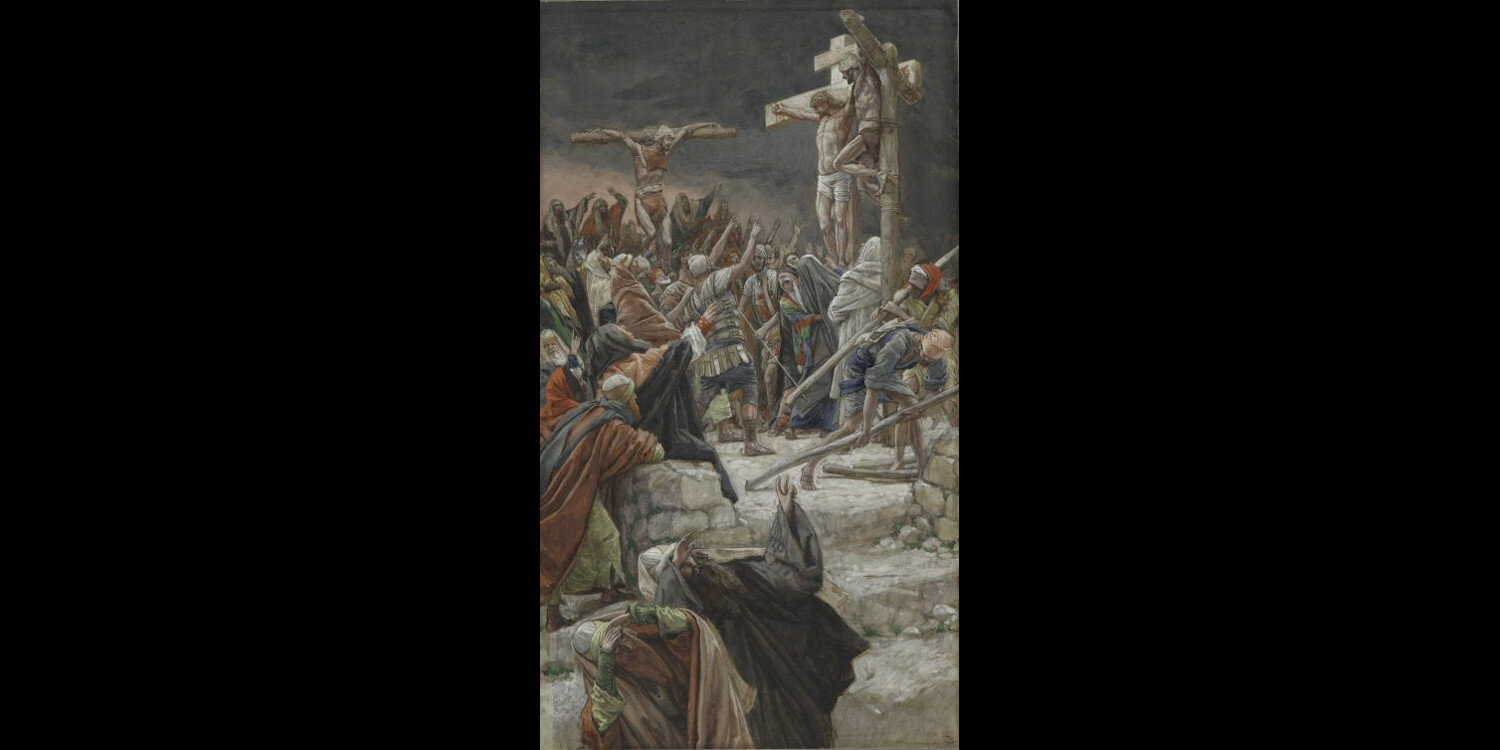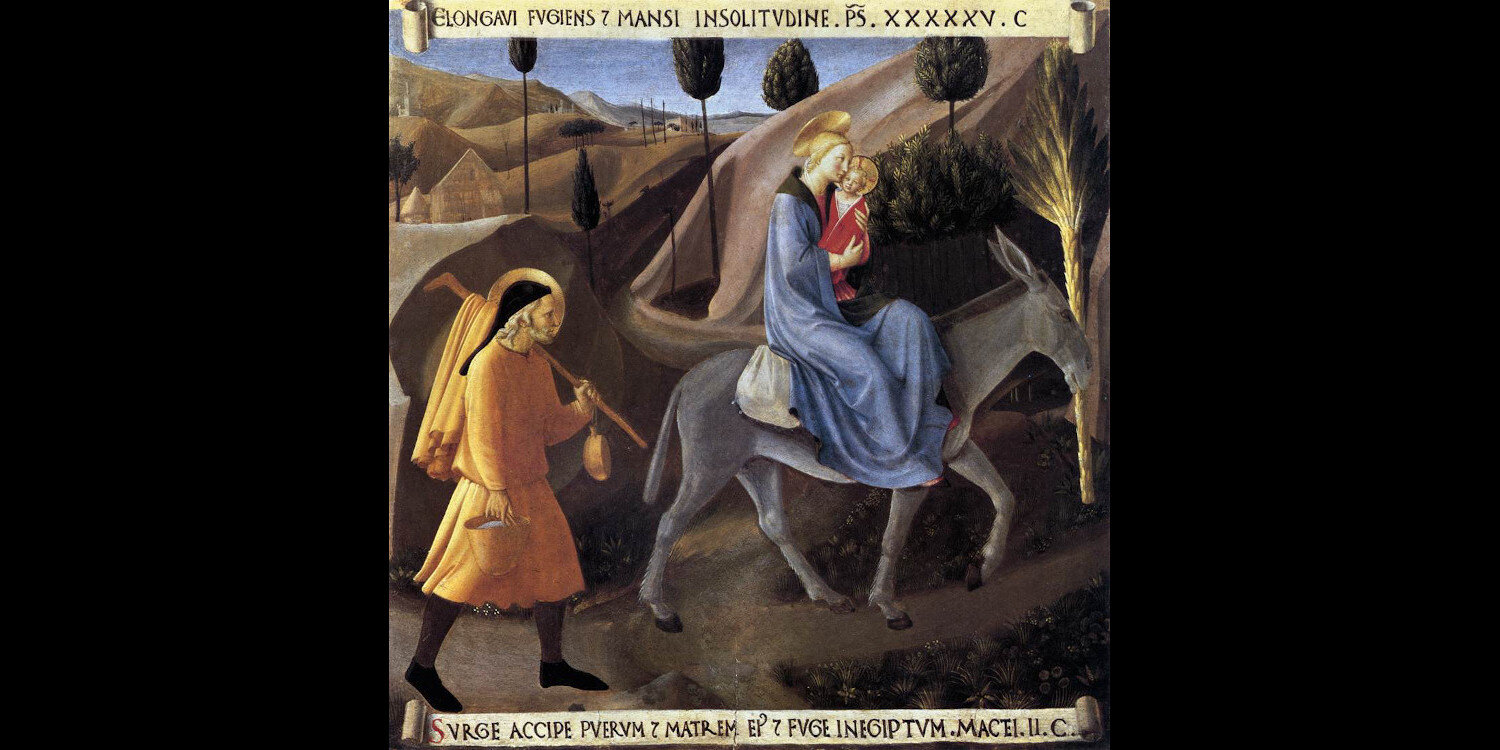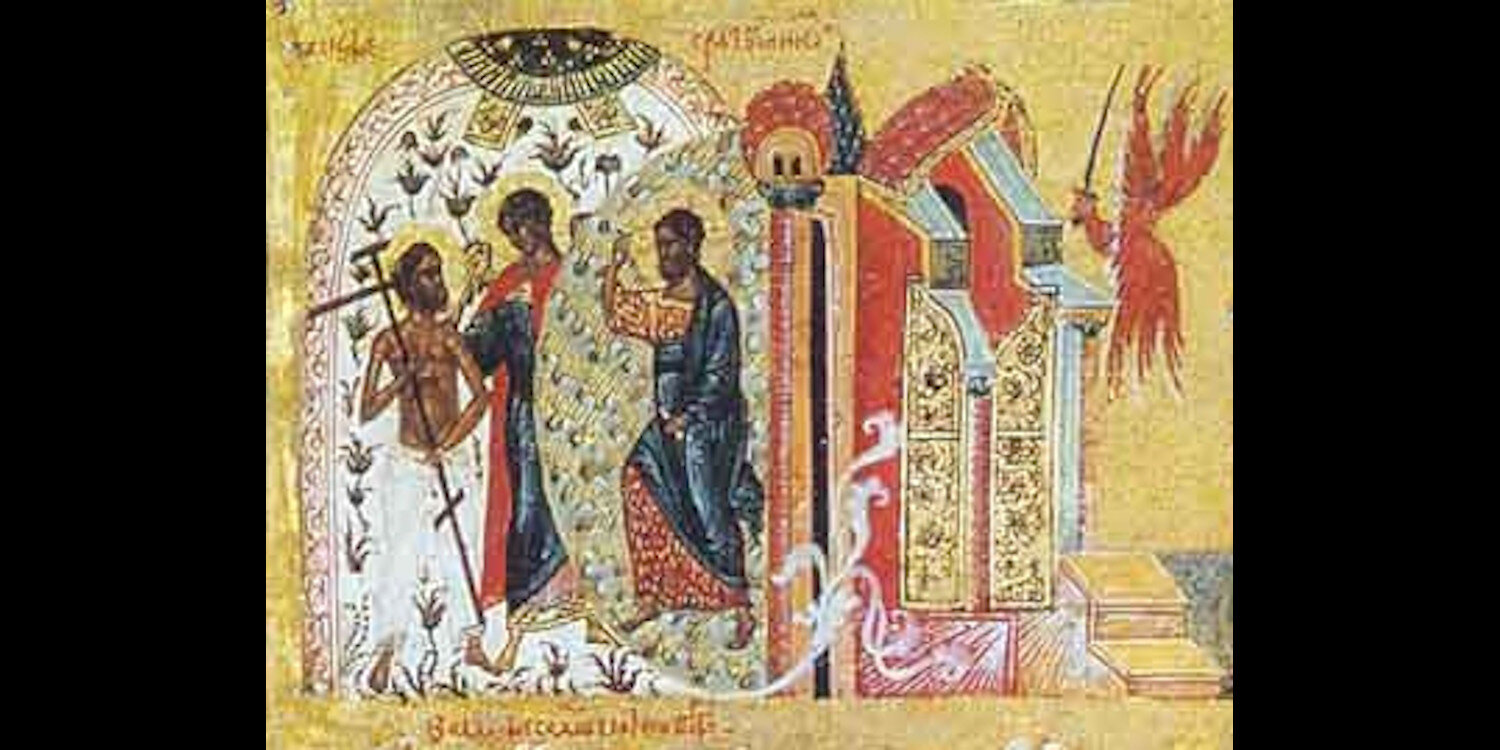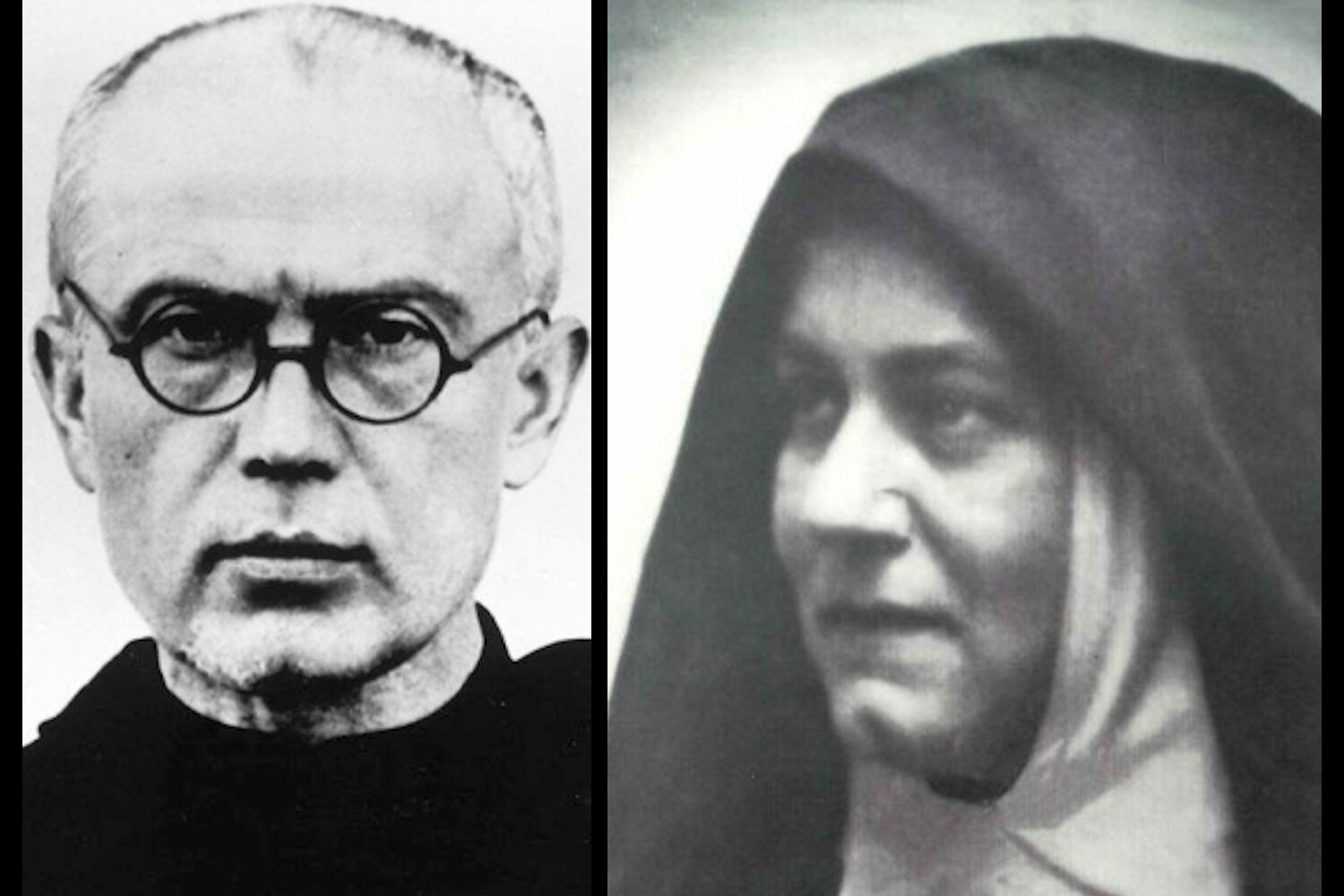“There are few authentic prophetic voices among us, guiding truth-seekers along the right path. Among them is Fr. Gordon MacRae, a mighty voice in the prison tradition of John the Baptist, Maximilian Kolbe, Alfred Delp, SJ, and Dietrich Bonhoeffer.”
— Deacon David Jones
Dismas, Crucified to the Right: Paradise Lost and Found
Who was Saint Dismas, the Penitent Thief, crucified to the right of Jesus at Calvary? His brief Passion Narrative appearance has deep meaning for Christians.
Who was Saint Dismas, the penitent criminal, crucified to the right of Jesus at Calvary? His brief Passion Narrative appearance has deep meaning for Salvation.
“All who see me scoff at me. They mock me with parted lips; they wag their heads.”
During Holy Week one year, I wrote “Simon of Cyrene, the Scandal of the Cross, and Some Life Sight News.” It was about the man recruited by Roman soldiers to help carry the Cross of Christ. I have always been fascinated by Simon of Cyrene, but truth be told, I have no doubt that I would react with his same spontaneous revulsion if fate had me walking in his sandals that day past Mount Calvary.
Some BTSW readers might wish for a different version, but I cannot write that I would have heroically thrust the Cross of Christ upon my own back. Please rid yourselves of any such delusion. Like most of you, I have had to be dragged kicking and screaming into just about every grace I have ever endured. The only hero at Calvary was Christ. The only person worth following up that hill — up ANY hill — is Christ. I follow Him with the same burdens and trepidation and thorns in my side as you do. So don’t follow me. Follow Him.
This Holy Week, one of many behind these stone walls, has caused me to use a wider angle lens as I examine the events of that day on Mount Calvary as the Evangelists described them. This year, it is Dismas who stands out. Dismas is the name tradition gives to the man crucified to the right of the Lord, and upon whom is bestowed a dubious title: the “Good Thief.”
As I pondered the plight of Dismas at Calvary, my mind rolled some old footage, an instant replay of the day I was sent to prison — the day I felt the least priestly of all the days of my priesthood.
It was the mocking that was the worst. Upon my arrival at prison after trial late in 1994, I was fingerprinted, photographed, stripped naked, showered, and unceremoniously deloused. I didn’t bother worrying about what the food might be like, or whether I could ever sleep in such a place. I was worried only about being mocked, but there was no escaping it. As I was led from place to place in chains and restraints, my few belongings and bedding stuffed into a plastic trash bag dragged along behind me, I was greeted by a foot-stomping chant of prisoners prepped for my arrival: “Kill the priest! Kill the priest! Kill the priest!” It went on into the night. It was maddening.
It’s odd that I also remember being conscious, on that first day, of the plight of the two prisoners who had the misfortune of being sentenced on the same day I was. They are long gone now, sentenced back then to just a few years in prison. But I remember the walk from the courthouse in Keene, New Hampshire to a prison-bound van, being led in chains and restraints on the “perp-walk” past rolling news cameras. A microphone was shoved in my face: “Did you do it, Father? Are you guilty?”
You may have even witnessed some of that scene as the news footage was recently hauled out of mothballs for a WMUR-TV news clip about my new appeal. Quickly led toward the van back then, I tripped on the first step and started to fall, but the strong hands of two guards on my chains dragged me to my feet again. I climbed into the van, into an empty middle seat, and felt a pang of sorrow for the other two convicted criminals — one in the seat in front of me, and the other behind.
“Just my %¢$#@*& luck!” the one in front scowled as the cameras snapped a few shots through the van windows. I heard a groan from the one behind as he realized he might vicariously make the evening news. “No talking!” barked a guard as the van rolled off for the 90 minute ride to prison. I never saw those two men again, but as we were led through the prison door, the one behind me muttered something barely audible: “Be strong, Father.”
Revolutionary Outlaws
It was the last gesture of consolation I would hear for a long, long time. It was the last time I heard my priesthood referred to with anything but contempt for years to come. Still, to this very day, it is not Christ with whom I identify at Calvary, but Simon of Cyrene. As I wrote in “Simon of Cyrene and the Scandal of the Cross“:
“That man, Simon, is me . . . I have tried to be an Alter Christus, as priesthood requires, but on our shared road to Calvary, I relate far more to Simon of Cyrene. I pick up my own crosses reluctantly, with resentment at first, and I have to walk behind Christ for a long, long time before anything in me compels me to carry willingly what fate has saddled me with . . . I long ago had to settle for emulating Simon of Cyrene, compelled to bear the Cross in Christ’s shadow.”
So though we never hear from Simon of Cyrene again once his deed is done, I’m going to imagine that he remained there. He must have, really. How could he have willingly left? I’m going to imagine that he remained there and heard the exchange between Christ and the criminals crucified to His left and His right, and took comfort in what he heard. I heard Dismas in the young man who whispered “Be strong, Father.” But I heard him with the ears of Simon of Cyrene.
Like a Thief in the Night
Like the Magi I wrote of in “Upon a Midnight Not So Clear,” the name tradition gives to the Penitent Thief appears nowhere in Sacred Scripture. Dismas is named in a Fourth Century apocryphal manuscript called the “Acts of Pilate.” The text is similar to, and likely borrowed from, Saint Luke’s Gospel:
“And one of the robbers who were hanged, by name Gestas, said to him: ‘If you are the Christ, free yourself and us.’ And Dismas rebuked him, saying: ‘Do you not even fear God, who is in this condemnation? For we justly and deservedly received these things we endure, but he has done no evil.’”
What the Evangelists tell us of those crucified with Christ is limited. In Saint Matthew’s Gospel (27:38) the two men are simply “thieves.” In Saint Mark’s Gospel (15:27), they are also thieves, and all four Gospels describe their being crucified “one on the left and one on the right” of Jesus. Saint Mark also links them to Barabbas, guilty of murder and insurrection. The Gospel of Saint John does the same, but also identifies Barabbas as a robber. The Greek word used to identify the two thieves crucified with Jesus is a broader term than just “thief.” Its meaning would be more akin to “plunderer,” part of a roving band caught and given a death penalty under Roman law.
Only Saint Luke’s Gospel infers that the two thieves might have been a part of the Way of the Cross in which Saint Luke includes others: Simon of Cyrene carrying Jesus’ cross, and some women with whom Jesus spoke along the way. We are left to wonder what the two criminals witnessed, what interaction Simon of Cyrene might have had with them, and what they deduced from Simon being drafted to help carry the Cross of a scourged and vilified Christ.
In all of the Gospel presentations of events at Golgotha, Jesus was mocked. It is likely that he was at first mocked by both men to be crucified with him as the Gospel of St. Mark describes. But Saint Luke carefully portrays the change of heart within Dismas in his own final hour. The sense is that Dismas had no quibble with the Roman justice that had befallen him. It seems no more than what he always expected if caught:
“One of the criminals who were hanged railed at him, saying, ‘Are you not the Christ? Save yourself and us!’ But the other rebuked him, saying, ‘Do you not fear God since you are under the same sentence of condemnation? And we indeed justly, for we are receiving the due reward of our deeds; but this man has done nothing wrong.’ ”
The Flight into Egypt
The name, “Dismas” comes from the Greek for either “sunset” or “death.” In an unsubstantiated legend that circulated in the Middle Ages, in a document known as the “Arabic Gospel of the Infancy,” this encounter from atop Calvary was not the first Gestas and Dismas had with Jesus. In the legend, they were a part of a band of robbers who held up the Holy Family during the Flight into Egypt after the Magi departed in Saint Matthews Gospel (Matthew 2:13-15).
This legendary encounter in the Egyptian desert is also mentioned by Saint Augustine and Saint John Chrysostom who, having heard the same legend, described Dismas as a desert nomad, guilty of many crimes including the crime of fratricide, the murder of his own brother. This particular part of the legend, as you will see below, may have great symbolic meaning for salvation history.
In the legend, Saint Joseph, warned away from Herod by an angel (Matthew 2:13-15), opted for the danger posed by brigands over the danger posed by Herod’s pursuit. Fleeing with Mary and the child into the desert toward Egypt, they were confronted by a band of robbers led by Gestas and a young Dismas. The Holy Family looked like an unlikely target having fled in a hurry, and with very few possessions. When the robbers searched them, however, they were astonished to find expensive gifts of gold, frankincense, and myrrh — the Gifts of the Magi. However, in the legend Dismas was deeply affected by the infant, and stopped the robbery by offering a bribe to Gestas. Upon departing, the young Dismas was reported to have said:
“0 most blessed of children, if ever a time should come when I should crave thy mercy, remember me and forget not what has passed this day.”
Paradise Found
The most fascinating part of the exchange between Jesus and Dismas from their respective crosses in Saint Luke’s Gospel is an echo of that legendary exchange in the desert 33 years earlier — or perhaps the other way around:
“‘Jesus, remember me when you come into your kingly power.’ And he said to him, ‘Truly I say to you, today you will be with me in Paradise.’”
The word, “Paradise” used by Saint Luke is the Persian word, “Paradeisos” rarely used in Greek. It appears only three times in the New Testament. The first is that statement of Jesus to Dismas from the Cross in Luke 23:43. The second is in Saint Paul’s description of the place he was taken to momentarily in his conversion experience in Second Corinthians 12:3 — which I described in “The Conversion of Saint Paul and the Cost of Discipleship.” The third is the heavenly paradise that awaits the souls of the just in the Book of Revelation (2:7).
In the Old Testament, the word “Paradeisos” appears only in descriptions of the Garden of Eden in Genesis 2:8, and in the banishment of Cain after the murder of his brother, Abel:
“Cain left the presence of the Lord and wandered in the Land of Nod, East of Eden.”
Elsewhere, the word appears only in the prophets (Isaiah 51:3 and Ezekiel 36:35) as they foretold a messianic return one day to the blissful conditions of Eden — to the condition restored when God issues a pardon to man.
If the Genesis story of Cain being banished to wander “In the Land of Nod, East of Eden” is the symbolic beginning of our human alienation from God — the banishment from Eden marking an end to the State of Grace and Paradise Lost — then the Dismas profession of faith in Christ’s mercy is symbolic of Eden restored — Paradise Regained.
From the Cross, Jesus promised Dismas both a return to spiritual Eden and a restoration of the condition of spiritual adoption that existed before the Fall of Man. It’s easy to see why legends spread by the Church Fathers involved Dismas guilty of the crime of fratricide just as was Cain.
A portion of the cross upon which Dismas is said to have died alongside Christ is preserved at the Church of Santa Croce in Rome. It’s one of the Church’s most treasured relics. Catholic apologist, Jim Blackburn has proposed an intriguing twist on the exchange on the Cross between Christ and Saint Dismas. In “Dismissing the Dismas Case,” an article in the superb Catholic Answers Magazine Jim Blackburn reminded me that the Greek in which Saint Luke’s Gospel was written contains no punctuation. Punctuation had to be added in translation. Traditionally, we understand Christ’s statement to the man on the cross to his right to be:
“Truly I say to you, today you will be with me in Paradise.”
The sentence has been used by some non-Catholics (and a few Catholics) to discount a Scriptural basis for Purgatory. How could Purgatory be as necessary as I described it to be in “The Holy Longing” when even a notorious criminal is given immediate admission to Paradise? Ever the insightful thinker, Jim Blackburn proposed a simple replacement of the comma giving the verse an entirely different meaning:
“Truly I say to you today, you will be with me in Paradise.”
Whatever the timeline, the essential point could not be clearer. The door to Divine Mercy was opened by the events of that day, and the man crucified to the right of the Lord, by a simple act of faith and repentance and reliance on Divine Mercy, was shown a glimpse of Paradise Regained.
The gift of Paradise Regained left the cross of Dismas on Mount Calvary. It leaves all of our crosses there. Just as Cain set in motion our wandering “In the Land of Nod, East of Eden,” Dismas was given a new view from his cross, a view beyond death, away from the East of Eden, across the Undiscovered Country, toward eternal home.
Saint Dismas, pray for us.
+ + +
Saints and Sacrifices: Maximilian Kolbe and Edith Stein at Auschwitz
Saint Maximilian Kolbe and Saint Teresa Benedicta of the Cross — Edith Stein — are honored this week as martyrs of charity and sacrifice.
Saint Maximilian Kolbe and Saint Teresa Benedicta of the Cross — Edith Stein — are honored this week as martyrs of charity and sacrifice.
In a post some years ago I invited our readers to join my friend Pornchai Moontri and me in a personal Consecration to Saint Maximilian Kolbe’s dual movements: the Militia of the Immaculata and the Knights at the Foot of the Cross. Our Consecration took place at Mass on the night of August 15, the Solemnity of the Assumption, and the day after Saint Maximilian’s Feast Day. Visit the website of the Militia of the Immaculata for instructions for enrolling in the Militia Immaculata and the Knights at the Foot of the Cross.
We’re very moved by the number of people who have pledged to join us in this Consecration. The invitation remains always open.
Consecration as members of Saint Maximilian’s M.I. or Knights at the Foot of the Cross does not mean I plan to take on any more suffering or that I will never again complain. It does not even mean that I accept with open arms whatever crosses I bear and embrace them.
A person who is unjustly imprisoned must do all in his power to reverse that plight just as a person with cancer must do everything possible to be restored to health. Consecration does not mean we will simply acquiesce to suffering and look for more. It means we embrace the suffering of Christ, and offer our own as a share in it. In the end, I know I cannot empty myself, as Christ did, but I can perhaps attain the attitude of “Simon of Cyrene: Compelled to Carry the Cross,” of which my own is but a splinter.
I have written in the past that history has a tendency to treat its events lightly. The centuries have made Saint Patrick, for example, a sort of whimsical figure. History has distorted the fact that he became the saint he is after great personal suffering. Patrick was kidnapped by Irish raiders at the age of 16, forced from his home and family, taken across the Irish Sea and forced into slavery.
The life and death of Saint Maximilian are still too recent to be subjected to the colored glasses through which we often view history and sainthood. As with nearly all the saints — and with some of us who simply struggle to believe — great suffering was imposed on Maximilian Kolbe and he responded in a way that revealed a Christ-centered rather than self-centered life. What happened to Father Maximilian Kolbe must not be removed from what the Germans would call his “sitz im leben,” the “setting in life” of Auschwitz and the Holocaust. As evil as they were, they were the forges in which Maximilian cast off self and took on the person of Christ.
Scene from the 1978 mini-series “Holocaust”
“And the Winner Is . . .”
Do you remember the television “mini-series” productions of the 1970s and 1980s? After the great success of bringing Alex Haley’s “Roots” to the screen, several other forays into history were aired in our living rooms. One of them was a superb and compelling series entitled “Holocaust” that debuted on NBC on April 16, 1978. It was a brilliant and powerful example of television’s potential.
“Holocaust” won several Emmy Awards for NBC in 1978 for outstanding Limited Series, Best Director (Marvin Chomsky), Best Screenplay (Gerald Green), Best Actor (Michael Moriarty), Best Actress (Meryl Streep) and a number of Supporting Actor and other awards. As a historical narrative, however, “Holocaust” was deeply disturbing and shook an otherwise comfortable generation all too inclined to want to forget and move on. That was a complaint during the famous Nuremberg Trials of 1945 and 1946.
Just two years after the Allied Invasion of Germany and Poland ended the war and exposed the Death Camps, writers complained that Americans had lost interest and were not reading about the Nuremberg Trials. The aftermath of war revealed the sheer evil of the Nazi Final Solution, and it was more than most of us could bear to look at — so many did not look.
As I wrote in “Catholic Scandal and the Third Reich,” there are some who would have you believe that the Catholic Church is to be the moral scapegoat of the 20th Century. Viewing “Holocaust” (the miniseries) would quickly shatter any such revisionist history. Its first episode was so graphic in its depiction of Nazi oppression, and caused me so much anguish, that I struggled with whether to watch the rest.
I was 25 years old when it first aired, and finishing senior year at Saint Anselm College, a Benedictine school in New Hampshire. I was a double major in philosophy and psychology, and was in the middle of writing my psychology thesis on the relationship between trauma and depression when “Holocaust” kept me awake all night.
The morning after that first episode, I sought out a friend, an elderly Benedictine monk on campus who recommended the series to me. I thought he might tell me to turn my television off, but I was wrong. “This happened in my lifetime,” he said. “We cannot run from it. So don’t look away. Stare straight into its heart of darkness, and never forget what you see.”
He was right, and his words were eerily similar to those of biographer, George Weigel, who wrote of Pope John Paul II and his interest in Saint Maximilian Kolbe in Witness to Hope (HarperCollins, 1999):
Maximilian Kolbe . . . was the ‘saint of the abyss’ — the man who looked into the modern heart of darkness and remained faithful to Christ by sacrificing his life for another in the Auschwitz starvation bunker while helping his cellmates die with dignity and hope.
— Witness to Hope, p. 447
That was what the Holocaust was: “the modern heart of darkness.” I have been a student of the Holocaust since, but I am no closer to understanding it than I was on that sleepless night in 1978. As I asked in “Catholic Scandal and the Third Reich”:
“How did a society come to stand behind the hateful rhetoric of one man and his political machine? How did masses of people become convinced that any ideology of the state was worth the horror unfolding before their eyes?”
We have all been reading about the breakdown of faith in Europe, and about how decades-old scandals are now being used to justify the abandonment of Catholicism in European culture. This is not a new phenomenon. This madness engulfed Europe just eighty years ago, and before it was over, six million of our spiritual ancestors were deprived of liberty, and then life, for being Jews.
Hitler’s “Final Solution” exterminated fully two-thirds of the Jewish men, women, and children of Europe — and millions of others who either stood in his way or spoke the truth. Among those imprisoned and murdered were close to 12,000 Catholic priests and thousands more women religious and other Catholics. The determination to rid Europe of the Judeo-Christian faith did not begin with claims of sexual abuse, and this is not the first time such claims were used to further that agenda.
The Great Lie and Revealed Truth
This of all weeks keeps me riveted on the Holocaust. It was in this week that two of my dearest spiritual friends were murdered a year apart at Auschwitz by that madman, Hitler, and his monstrous Third Reich. Father Maximilian Kolbe traded his life for that of a fellow prisoner on August 14, 1941, and Edith Stein — who became Carmelite Sister Teresa Benedicta of the Cross — was dragged from a cattle train and murdered along with her sister, Rosa, immediately upon arrival at Auschwitz on August 9, 1942.
We must not forget this line from Adolf Hitler’s Mein Kampf (Vol. 1, Ch.10, 1925): “The great mass of people … will more easily fall victim to a big lie than to a small one.” In order for a lie to disseminate and prevail, the truth must be controlled. In 1933, the Third Reich imposed the “Editor’s Law” in Germany requiring that editors and publishers join the Third Reich’s Literary Chamber or cease publishing. In 1933 there were over 400 Catholic newspapers and magazines published in Germany. By 1935 there were none.
The Nazi law was imposed in each country invaded by the Reich. In Poland, Father Maximilian was one of many priests sent to prison for his continued writings, but time in prison did not teach him the lesson intended by the Nazis. He was imprisoned again, and he would not emerge alive from his second sentence at Auschwitz. He was not alone in this. Nearly 12,000 priests were sent to their deaths in concentration camps.
“Come, Let Us Go For Our People.”
Edith Stein was the youngest of eleven children in a devout Jewish family in Germany. She was born on Yom Kippur, the Day of Atonement, on October 12, l891. As a young woman, Edith broke her mother’s heart by abandoning her Jewish faith in adolescent rebellion. She was also brilliant, and it was difficult to win an argument with her using reason and logic. She was a master of both.
Edith received her doctorate in philosophy under the noted phenomenologist, Edmund Husserl, and taught at a German university when the Nazis came to power in 1933. During this time of upheaval, Edith converted to Catholicism after stumbling across the autobiography of Saint Teresa of Avila. “This is the truth,” Edith declared after reading it through in one sleepless night. A few years after her conversion, Edith Stein entered a Carmelite convent in Germany taking the name Sister Teresa Benedicta of the Cross (Blessed by the Cross).
March 27, 1939 was Passion Sunday, the beginning of Holy Week. In response to a declaration of Adolf Hitler that the Jews would bring about their own extinction, Sister Teresa Benedicta of the Cross wrote a private note to her Carmelite superior. She offered herself in prayer as expiation against the Anti-Christ who had cast all of Europe into a spiritual stranglehold. In her letter to her superior, Sister Teresa offered herself as expiation for the Church, for the Jews, for her native Germany, and for world peace.
As the Nazi horror overtook Europe, Sister Teresa grew fearful that she was placing her entire convent at risk because of her Jewish roots. Edith was then assigned to a Carmelite Convent in Holland. Her sister, Rosa, who also converted to Catholicism, joined her there as a postulant.
Catholics in France, Belgium, Holland and throughout Europe organized to rescue tens of thousands of Jewish children from deportation to the Death Camps. Philip Friedman, in Roads to Extinction: Essays on the Holocaust (The Jewish Publication Society, 1980) commended the Catholic bishops of the Netherlands for their public protest about the Nazi deportation of Jews from Holland. In retaliation for those bishops’ actions, however, even Jews who had converted to Catholicism were rounded up for deportation to Auschwitz.
A 2010 book by Paul Hamans — Edith Stein and Companions: On the Way to Auschwitz — details the horror of that day. Hundreds of Catholic Jews were arrested in Holland in retaliation for the bishops’ open rebellion, and most were never seen again. This information stands in stark contrast to the often heard revisionist history that Pope Pius XII “collaborated” with the Nazis through his “silence.” He was credited by the chief rabbi of Rome, Eugenio Zolli, with having personally saved over 860,000 Jews and preventing untold numbers of deaths.
The last words heard from Sister Teresa as she was forced aboard a cattle car packed with victims were spoken to her sister, Rosa, “Come, let us go for our people.” On August 9, 1942, Sister Teresa emerged from the cramped human horror of that cattle train into the Auschwitz Death Camp to face The Sorting.
Nobel Prize winner and Holocaust survivor Elie Wiesel described The Sorting:
“How do you describe the sorting out on arriving at Auschwitz, the separation of children who see a father or mother going away, never to be seen again? How do you express the dumb grief of a little girl and the endless lines of women, children and rabbis being driven across the Polish or Ukranian landscapes to their deaths? No, I can’t do it. And because I’m a writer and teacher, I don’t understand how Europe’s most cultured nation could have done that.”
That August 9th, Edith Stein went no further into the depths of Auschwitz than The Sorting. Some SS officer glared at this brilliant 50-year-old nun in the tattered remains of her Carmelite habit, and declared that she was not fit for work. This woman who had worked every day of her life, who taught philosophy to Germany’s graduate students, who scrubbed convent floors each night, was determined to be “unfit for work” by a Nazi officer who knew it was a death sentence.
Edith and Rosa were taken directly to a cottage along with 113 others, packed in, the doors sealed, and they were gassed to death. Their remains, like those of Maximilian Kolbe a year earlier, went unceremoniously up in smoke to drift through the sky above Auschwitz. And Europe thinks it would be better off now without faith!
“Thus the way from Bethlehem leads inevitably to Golgotha, from the crib to the Cross. (Simeon’s) prophecy announced the Passion, the fight between light and darkness that already showed itself before the crib … The star of Bethlehem shines in the night of sin. The shadow of the Cross falls on the light that shines from the crib. This light is extinguished in the darkness that is Good Friday, but it rises all the more brilliantly in the sun of grace on the morning of the Resurrection.
“The way of the incarnate Son of God leads through the Cross and Passion to the glory of the Resurrection. In His company the way of everyone of us, indeed of all humanity, leads through suffering and death to this same glorious goal.”
— Edith Stein/Sister Teresa Benedicta of the Cross

